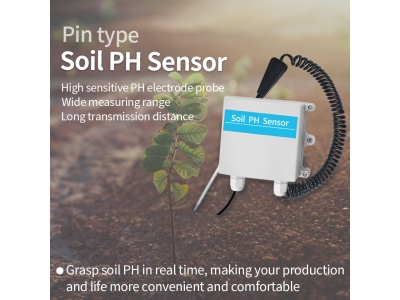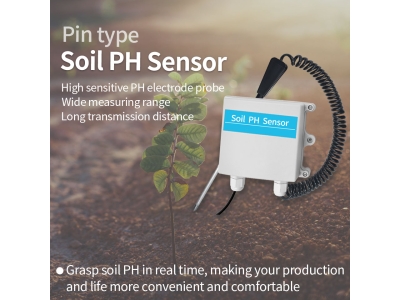
The whole soil sensor thing
Get ready to dive into the fascinating world of soil sensors and their potential to enhance crop yields, conserve resources, and promote sustainable farming practices.

Get ready to dive into the fascinating world of soil sensors and their potential to enhance crop yields, conserve resources, and promote sustainable farming practices.
In recent years, advancements in technology have revolutionized various industries, and agriculture is no exception. One of the most significant innovations in modern farming is the development and use of soil sensors. These sensors provide farmers with valuable data about soil conditions, enabling them to make informed decisions and optimize their agricultural practices. In this article, we will explore the concept of soil sensors, their benefits, and how they are transforming the way we approach agriculture. Get ready to dive into the fascinating world of soil sensors and their potential to enhance crop yields, conserve resources, and promote sustainable farming practices.

Understanding Soil Sensors
1.1 What are Soil Sensors?
Soil sensors are devices designed to measure various parameters within the soil, such as moisture content, temperature, pH levels, nutrient levels, and salinity. They are typically installed directly into the ground and utilize sophisticated technology to collect and transmit real-time data.
1.2 Types of Soil Sensors:
There are several types of soil sensors available, each designed to measure specific soil properties. Some common types include moisture sensors, temperature sensors, electrical conductivity sensors, pH sensors, and nitrate sensors. Each sensor type provides valuable insights into different aspects of soil health.
1.3 How Soil Sensors Work:
Soil sensors work by employing different technologies to measure specific soil properties. For example, moisture sensors may use capacitance, tensiometry, or time-domain reflectometry techniques to assess soil moisture levels. Other sensors may rely on electrochemical or optical methods to detect pH or nutrient levels.
Benefits of Soil Sensors
2.1 Improved Water Management:
One of the primary benefits of soil sensors is enhanced water management. By accurately measuring soil moisture levels, farmers can determine when and how much irrigation is necessary. This helps prevent overwatering or underwatering, leading to more efficient water usage and reduced water waste.
2.2 Optimal Nutrient Application:
Soil sensors allow farmers to monitor nutrient levels in real-time, ensuring that crops receive the appropriate amount of fertilizers. This precision reduces the risk of nutrient deficiencies or excesses, leading to healthier plants and increased crop yields. Furthermore, it helps minimize the environmental impact of excessive fertilizer use.
2.3 Enhanced Crop Yield:
By providing valuable insights into soil conditions, such as moisture, temperature, and nutrient availability, soil sensors enable farmers to optimize growing conditions for their crops. This optimization leads to improved crop yields, as plants can thrive in conditions that are tailored to their specific needs.
2.4 Resource Conservation:
Effective use of soil sensors helps conserve resources such as water, fertilizers, and energy. By only applying irrigation and fertilizers when needed, farmers can significantly reduce waste and minimize the environmental impact of their farming practices. Additionally, efficient resource management can result in cost savings for farmers.
2.5 Early Pest and Disease Detection:
Changes in soil conditions can indicate the presence of pests or diseases that may affect crop health. Soil sensors can detect these changes, allowing farmers to take proactive measures to address the issue promptly. By identifying problems early, farmers can implement targeted pest control strategies, reducing the need for broad-spectrum pesticides.
Implementing Soil Sensors in Agriculture
3.1 Choosing the Right Soil Sensors:
When implementing soil sensors, it is essential to select the appropriate sensors for your specific needs. Consider factors such as the type of crops grown, desired parameters to measure, and budget constraints. Consult with experts or agricultural consultants to ensure you choose sensors that align with your goals.
3.2 Sensor Placement and Installation:
Proper sensor placement is crucial for accurate data collection. Follow the manufacturer's instructions to install the sensors at appropriate depths and locations within the field. Consider factors such as soil variability and root zone depth to obtain representative data.
3.3 Data Collection and Analysis:
Soil sensors generate a wealth of data that needs to be collected and analyzed effectively. Utilize data loggers or connect the sensors to a centralized system for real-time monitoring. Analyze the collected data to identify trends, make informed decisions, and optimize agricultural practices.
3.4 Integration with Precision Agriculture Technologies:
Soil sensors can be integrated with other precision agriculture technologies, such as GPS and yield monitors. This integration enables farmers to create detailed maps of soil variability within their fields and implement variable rate application techniques. By tailoring inputs to specific areas, farmers can maximize productivity and minimize waste.
Section 4: Challenges and Future Developments
4.1 Cost Considerations:
The cost of soil sensors can be a barrier for some farmers, particularly small-scale growers. However, as technology advances and adoption rates increase, the cost of these sensors is likely to decrease, making them more accessible to a broader range of farmers.
4.2 Data Interpretation and Decision-Making:
Collecting data from soil sensors is just the first step. Analyzing and interpreting the data can be complex, requiring knowledge and expertise. Farmers may need assistance from agronomists or agricultural consultants to make informed decisions based on the sensor data.
4.3 Advances in Sensor Technology:
The field of soil sensing is continuously evolving, with ongoing research and development efforts focused on improving sensor accuracy, durability, and ease of use. Future advancements may include sensors that measure additional parameters, increased wireless connectivity options, and improved data analysis tools.
Conclusion:
Soil sensors are transforming the agricultural landscape by providing farmers with valuable insights into soil conditions. From optimizing water and nutrient management to enhancing crop yields and promoting sustainability, soil sensors offer numerous benefits for modern farming practices. By implementing soil sensors and utilizing the data they provide, farmers can make informed decisions, increase productivity, and contribute to a more sustainable future for agriculture. Embrace the whole soil sensor thing and unlock the potential of your farm!